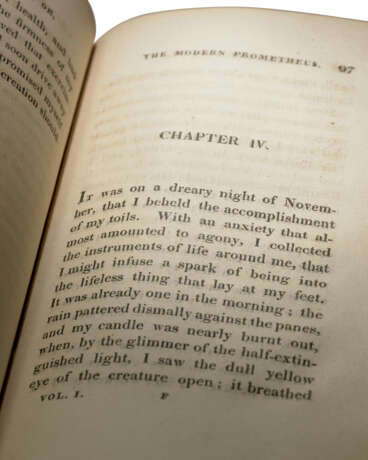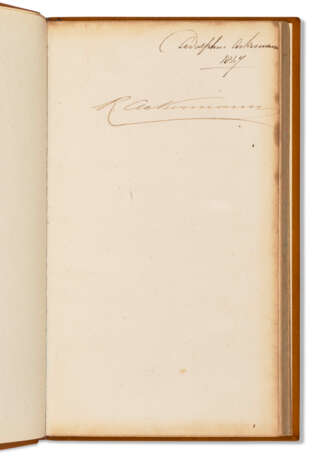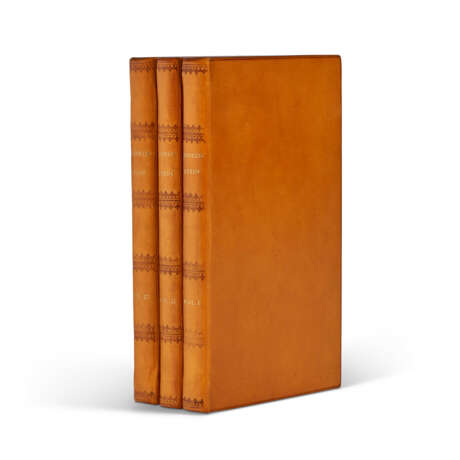ID 813720
Lot 132 | Frankenstein
Valeur estimée
$ 200 000 – 300 000
Mary Shelley, 1818
[SHELLEY, Mary Wollstonecraft (1797-1851).] Frankenstein: or, The Modern Prometheus. London: Lackington, Hughes, Harding, Mavor, and Jones, 1818.
The first edition, belonging to the great London publishers Rudolph and Adolphus Ackermann—a tantalizing association. And also a very clean, fresh copy internally. Rudolph Ackermann Sr. published Mary Shelley's story "Lacy De Vere" as an anonymous work in the 1827 edition of his literary annual, Forget Me Not. It was their first and only partnership (although Mary Shelley wrote to him once more a few years later pitching another contribution). Because the ownership signatures are also dated 1827, it is tantalizing to think that either Ackermann was given this copy of Frankenstein by his new author or that she may have given it directly to his teenage son, Adolphus. Adolphus at the time was only slightly younger than Mary Shelley was when she wrote it. Adolphus's ownership signature is dated 1827 in each volume; he was evidently proud of the acquisition. Moreover, any three-volume set of Frankenstein with contemporary ownership inscriptions in each volume is rare and desirable.
Frankenstein was conceived during the rainy summer of 1816 beside Lake Geneva, where the author and Percy Shelley were staying with Lord Byron. It was Byron’s suggestion that the group, who had amused themselves with reading French translations of German ghost stories, should each write their own. In the preface to the 1831 edition, Mary Shelley writes: “I busied myself to think of a story, —a story to rival those which had excited us to this task. One which would speak to the mysterious fears of our nature, and awaken thrilling horror—one to make the reader dread to look round, to curdle the blood, and quicken the beatings of the heart.” The idea came to her in an “acute mental vision” as she tried to sleep: “I saw the pale student of unhallowed arts kneeling beside the thing he had put together. I saw the hideous phantasm of a man stretched out, and then, on the working of some powerful engine, show signs of life, and stir with an uneasy, half vital motion.” The young Shelley's work was first rejected by several publishers before finding a home at the small firm of Lackington, Hughes, et al. By contrast, Ackermann & Co., were already the leading publisher of color-plate books, publications at the opposite end of the spectrum from the modest first printing of Frankenstein.
Published anonymously on 1 January 1818 in a run of only 500 copies, the first edition included a preface written by Percy Shelley and a dedication to the author’s father, William Godwin. Its narrative, of a living being fashioned with materials found in "the dissecting room and the slaughter-house" and rejected by its maker, has now reached the same mythic cultural status as Don Quixote and Robinson Crusoe. Yet the reviews at the time were mixed, with the Quarterly Review sufficiently morally outraged to wonder "whether the head or the heart of the author be the most diseased," while Walter Scott praised her “original genius” and “uncommon powers of poetic imagination.”
Three volumes, 12mo (173 x 106mm). Without half-titles or advertisements. (A few freckles to first several leaves in vol. 2, vol. 2 title with a short closed tear at gutter margin.) 20th century polished calf, spines gilt. Custom quarter morocco box. Provenance: Adolphus Ackermann, 1810-1858 (ownership signatures in each volume dated 1827) – R[udolph] Ackermann, [Jr.], 1793-1868 (ownership signatures in each volume).
| Adresse de l'enchère |
CHRISTIE'S 20 Rockefeller Plaza 10020 New York Etats-Unis | ||||||||||||||
|---|---|---|---|---|---|---|---|---|---|---|---|---|---|---|---|
| Aperçu |
| ||||||||||||||
| Téléphone | +1 212 636 2000 | ||||||||||||||
| Fax | +1 212 636 4930 | ||||||||||||||
| Conditions d'utilisation | Conditions d'utilisation | ||||||||||||||
| transport |
Service postal Service de messagerie ramassage par vous-même | ||||||||||||||
| Modes de paiement |
Virement bancaire | ||||||||||||||
| Heures d'ouverture | Heures d'ouverture
|






